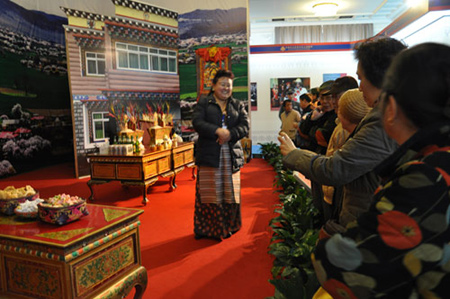You probably tend to gradually forget what has happened in old Tibet with the passage of the time. But those historical records may remind you: there's nothing else quite like "truth".
Tibetan traditional New Year, which fell on yesterday, has pushed "the Roof of the World" into spotlight once again. You can read the happiness on the face of Tibetans all over the country, who began a completely new life 50 years ago. The five decades have witnessed the past and the present of Tibet.
With a large number of pictures and real objects, the exhibition on Democratic Reform in Tibet, which runs from February 24 to April 10, has attracted a stream of visitors in the first three days.
|

|
|
Photo taken on Feb. 26, 2009 shows visitors watch the video about the riot in Lhasa on March. 14, 2008 in the Exhibition of Democratic Reforms in Tibet, which runs from Feb.24 to April 10 in the Exhibition Center of the Cultural Palace of Nationalities, Beijing. (Xinhuanet/ Huangrui) |
A college student from the Central Conservatory of Music, who majors in the fiddle, visited this exhibit with her mother. She said: "As a post-80's youth, I take a greater interest in Tibet's history. What I knew about the serfdom and dire poverty that Tibetan had suffered was all from textbooks. Such understanding was so abstract that it's hard to tune myself into it…"
"But today, I am deeply moved by these vivid pictures that give a strong visual impact on me. Especially the contrast between the past and the present has brought me to a more direct and more profound knowledge of serfdom's cruelty in old Tibet. "
"It is absurd for someone to describe old Tibet as 'a beautiful land', and to be blind completely to the reality at that time - the feudal serfdom, "the girl said.
 |
|
Photo taken on Feb. 26 shows visitors inquire a staff about customs in Tibetan tradional New Year in the Exhibition of Democratic Reforms in Tibet, which runs from Feb. 24 to April 10 in the Exhibition Center of the Cultural Palace of Nationalities, Beijing. (Xinhuanet/ Huangrui) |
Mr. Wang, a media worker, came to Beijing on business last Friday: "I have never been to Tibet before. Thus, I take this opportunity to learn more about its traditional customs, natural geography and cultural environment. "
"In my mind, Tibet is a tourist attraction with a blue sky and vast grasslands. Having watched this exhibition, I find its economic growth also remarkable. The local transport facilities are not as backward as I imagined and various high-tech products are used in people's daily life. This indeed gave me a great surprise, " Wang said, "We should cherish what we have today because we made it with great painstaking efforts. Anyway, all these achievements that Tibet has made are really encouraging. "
A British visitor who asked to be anonymous said he has lived in China for eight years. He indicated that his hopes the western people, especially the young, should keep an open mind to learning about Tibet. "If they had been able to see these pictures and video clips for themselves, they would have found they are wrong...They should check the truth before they jump at a conclusion … What they know about Tibet are but high mountains, blue skies… that's romantic, you know. The truth is under the complexity that you have to look into it. On Tibet's issue, some people have their own purpose to look it on, but it doesn't mean they are directed against China. With all the efforts that China has made, Tibet's prosperity will become better…"
|

|
|
Tibetan staffs make butter sculptures on spot at the third hall of the Exhibition of Democratic Reforms in Tibet, which runs from Feb. 24 to April 10 in the Exhibition Center of the Cultural Palace of Nationalities. (Xinhuanet/ Zhang Mingyu) |
The 50 years of reform have ensured equality, unity, mutual help and common prosperity. Tibet has been an inseparable part of China since ancient times. In the Chinese history, the Tibetan and Han people have always fought shoulder to shoulder to resist foreign invasion. In the Anti-Japanese War, Tibet was the air passage through which China carried the strategic materials to Burma in support of the anti-fascist war in South Asia. Today, climbers are able to find the wreckage of aircrafts when climbing the Everest.
Fact speaks louder than eloquence. Let's make truth tell itself.
(Xinhua News Agency February 26, 2009)